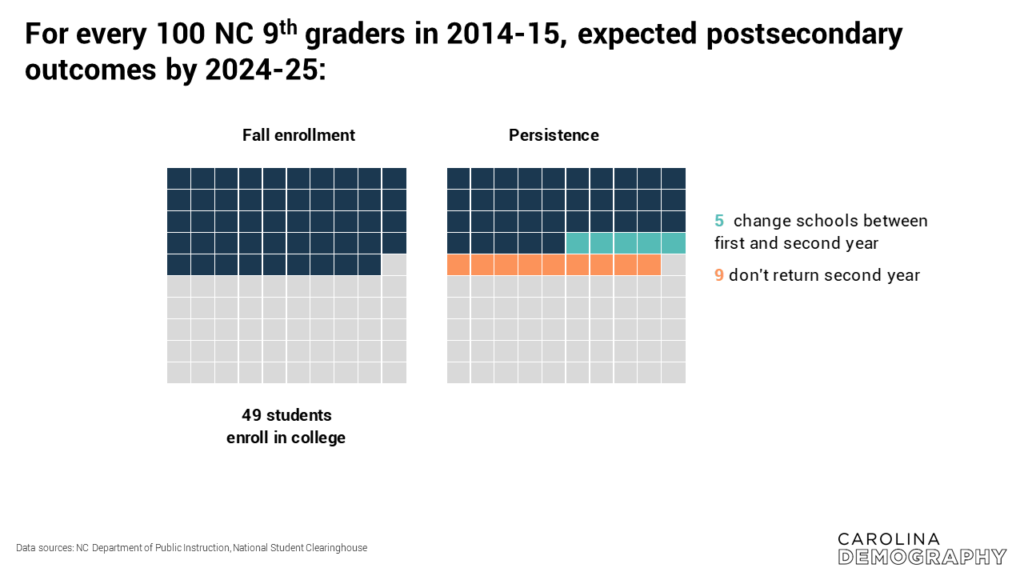100 students start 9th grade in NC. What happens next?

Between 2014 and 2026, nearly 1.6 million students will enter the state’s K-12 public school system as ninth graders. Under current graduation rates, more than 213,000 of them are predicted to drop out or delay high school graduation.
Let’s break it down further.
For every 100 ninth graders that start public high school in NC:
In 12th grade, all public high school graduates in NC are asked in the spring what they intend to do after graduation. Of the 86 students that complete high school on time:
Of the 71 students who say they intend to go on to post-secondary schooling:
But not everyone shows up to college in the fall, as our recent analysis of North Carolina’s public postsecondary pipeline shows. Transition to college is the largest loss point in the postsecondary pipeline. Many high school graduates with postsecondary intentions do not matriculate in the fall, a process known as “summer melt.” Summer melt most often affects first-generation college students, low-income students, and students with intentions to enroll in a community college. Research finds that small-scale interventions, such as summertime college counseling or text messaging campaigns, are effective at reducing summer melt and can significantly increase first-year enrollment.
In NC, of the 71 students who say they intend to go to postsecondary education, only 49 of them enroll.
And of the 49 that enroll, 9 don’t return for a second year. Five more change schools between their first and second year. 
And 15 return for a second year but don’t complete their degree or credential within 6 years.
Out of the 49 students who initially enroll in college, 25 receive a postsecondary degree or credential within 6 years. 24 more students have completed some college, but don’t have a degree. Out of our original 100 ninth graders:
However, there are large differences in the predicted likelihood of postsecondary pipeline completion across demographic groups:
The challenge
North Carolina has set a goal for 2 million adults ages 25-44 to have postsecondary credential or degree by 2030; this represents about 67% of adults 25-44 with a postsecondary certificate, diploma, or associate degree or higher. But there are persistent inequities in educational outcomes between race and ethnic groups. Based on current projections, three underserved groups (Black, American Indian/Alaska Native, and Hispanic populations) will not meet the postsecondary attainment goal.
Of the 1.4 M children enrolled in public school in NC, 44% are Black, Hispanic, or American Indian. And these children are more likely to be first-generation college students, based on the current educational attainment of their parents.
Programs that reach, engage, and successfully enroll, retain, and graduate our state’s growing population of first-generation and minority students will be vital to ensure North Carolina’s progress towards any statewide attainment goal. Failure to improve these outcomes is not only detrimental to the future economic well-being of these children and their families: it will ensure that our state’s primary path to future attainment growth will be the continued reliance on in-migration of highly educated individuals from other states and countries.
Need help understanding population change and its impacts on your community or business? Carolina Demography offers demographic research tailored to your needs.
Contact us today for a free initial consultation.
Contact UsCategories: Education
Tags: community colleges, high school, K-12, myFutureNC, postsecondary pipeline, UNC

The Center for Women’s Health Research (CWHR) at the University of North Carolina School of Medicine released the 12th edition of our North Carolina Women’s Health Report Card on May 9, 2022. This document is a progress report on the…

Dr. Krista Perreira is a health economist who studies disparities in health, education, and economic well-being. In collaboration with the Urban Institute, she recently co-led a study funded by the Kate B. Reynolds Foundation to study barriers to access to…

Our material helped the NC Local News Lab Fund better understand and then prioritize their funding to better serve existing and future grant recipients in North Carolina. The North Carolina Local News Lab Fund was established in 2017 to strengthen…
Your support is critical to our mission of measuring, understanding, and predicting population change and its impact. Donate to Carolina Demography today.
Notifications